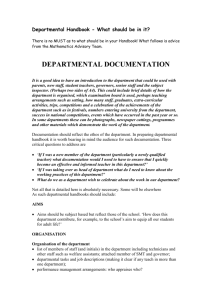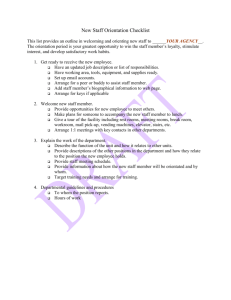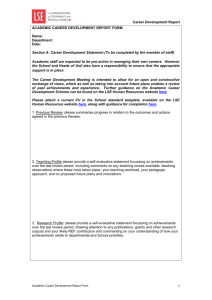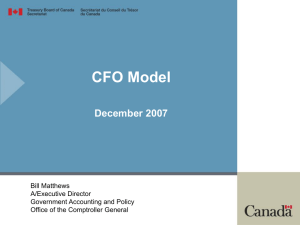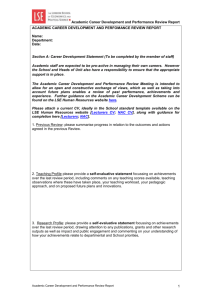Departmental Periodic Program Review
advertisement
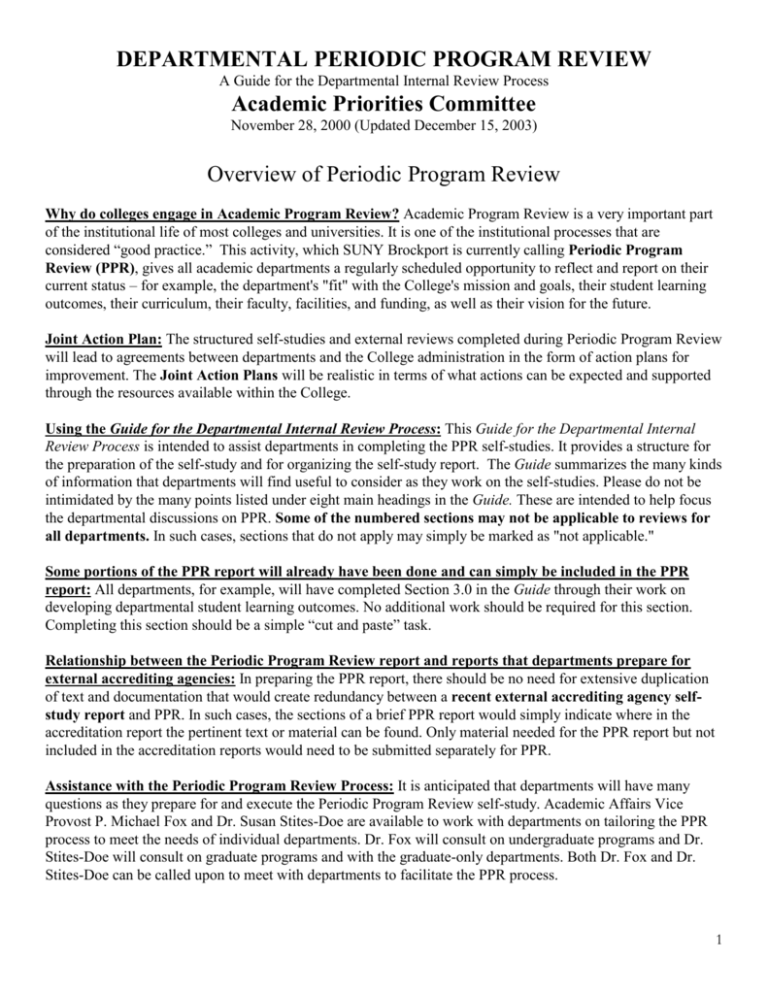
DEPARTMENTAL PERIODIC PROGRAM REVIEW A Guide for the Departmental Internal Review Process Academic Priorities Committee November 28, 2000 (Updated December 15, 2003) Overview of Periodic Program Review Why do colleges engage in Academic Program Review? Academic Program Review is a very important part of the institutional life of most colleges and universities. It is one of the institutional processes that are considered “good practice.” This activity, which SUNY Brockport is currently calling Periodic Program Review (PPR), gives all academic departments a regularly scheduled opportunity to reflect and report on their current status – for example, the department's "fit" with the College's mission and goals, their student learning outcomes, their curriculum, their faculty, facilities, and funding, as well as their vision for the future. Joint Action Plan: The structured self-studies and external reviews completed during Periodic Program Review will lead to agreements between departments and the College administration in the form of action plans for improvement. The Joint Action Plans will be realistic in terms of what actions can be expected and supported through the resources available within the College. Using the Guide for the Departmental Internal Review Process: This Guide for the Departmental Internal Review Process is intended to assist departments in completing the PPR self-studies. It provides a structure for the preparation of the self-study and for organizing the self-study report. The Guide summarizes the many kinds of information that departments will find useful to consider as they work on the self-studies. Please do not be intimidated by the many points listed under eight main headings in the Guide. These are intended to help focus the departmental discussions on PPR. Some of the numbered sections may not be applicable to reviews for all departments. In such cases, sections that do not apply may simply be marked as "not applicable." Some portions of the PPR report will already have been done and can simply be included in the PPR report: All departments, for example, will have completed Section 3.0 in the Guide through their work on developing departmental student learning outcomes. No additional work should be required for this section. Completing this section should be a simple “cut and paste” task. Relationship between the Periodic Program Review report and reports that departments prepare for external accrediting agencies: In preparing the PPR report, there should be no need for extensive duplication of text and documentation that would create redundancy between a recent external accrediting agency selfstudy report and PPR. In such cases, the sections of a brief PPR report would simply indicate where in the accreditation report the pertinent text or material can be found. Only material needed for the PPR report but not included in the accreditation reports would need to be submitted separately for PPR. Assistance with the Periodic Program Review Process: It is anticipated that departments will have many questions as they prepare for and execute the Periodic Program Review self-study. Academic Affairs Vice Provost P. Michael Fox and Dr. Susan Stites-Doe are available to work with departments on tailoring the PPR process to meet the needs of individual departments. Dr. Fox will consult on undergraduate programs and Dr. Stites-Doe will consult on graduate programs and with the graduate-only departments. Both Dr. Fox and Dr. Stites-Doe can be called upon to meet with departments to facilitate the PPR process. 1 DEPARTMENTAL PERIODIC PROGRAM REVIEW A Guide for the Departmental Internal Review Process Academic Priorities Committee November 28, 2000 Purpose of Departmental Periodic Program Review The purpose of the Departmental Periodic Program Review is to provide a mechanism through which a department/program and the College can develop a better understanding of the unit's contributions and needs. The ultimate goal of the review is to develop a Joint Action Plan, a set of actions for improvement agreed to by both the department and the College administration, with an appropriate time frame and a commitment of resources adequate to support these actions. Importance of demonstrating student success SUNY College at Brockport has established student success as the cornerstone of its mission as a College. It follows from this tenet that promoting and demonstrating student success must become the central focus both of undergraduate and graduate education including both General Education and the more specialized educational efforts based in the academic departments or “disciplines.” An approach of this kind leads to the need for the review of programs to emphasize assessment. Approach In some ways, this approach may represent a radical departure from the previous cycle of Periodic Program Review. While departmental statistics are important and will help in the work that departments must do to complete their program reviews, the departmental focus in the review should not be on amassing a thick portfolio of numbers. An important departmental emphasis in Periodic Program Review should be on defining what student success means and on demonstrating how close the department comes to achieving its own goals for student success. It is expected that, in the course of Periodic Program Review, the department will discover its own areas of strength as well as areas where improvement is needed. The end product should be a well-documented and reflective statement on the status of the department at this point in time and where the department would like to go in the future. Since the goal is to complete a departmental periodic program review every 5-8 years, this version of the Periodic Program Review should have 12-20% of all academic departments begin the process each academic year. The Deans and Vice President for Academic Affairs will identify departments for program review in an effort to coordinate this internal review with any external reviews or certifications departments may also be required to participate in. Participation in the review process As they carry out their program reviews, the faculty, staff, and students of the departments are expected to engage in an extensive internal dialogue. The department will be asked to develop an organizational plan for carrying out the Departmental Periodic Program Review in a way that ensures that this internal dialogue will take place (include plan in Appendix 1). In addition to the department’s internal dialogue that will culminate in a “self-study” or internal review document, it is expected that all departments will engage at least two external reviewers to work with them at appropriate points in the process. External reviewers are hired by the school dean in consultation with the department/program. Outline The following is an outline written to guide the process and content of the Departmental Periodic Program Review. The current core data for departmental statistics will be supplied as part of the information departments receive as they initiate their program reviews. 2 Departmental Periodic Program Review A Guide for the Departmental Internal Review Process Major sections of the Departmental Internal Review: 1.0 2.0 3.0 4.0 5.0 6.0 7.0 8.0 9.0 10.0 11.0 Statement of the Departmental Philosophy and Mission Results (Conclusions and Recommendations) of Previous Program Reviews Departmental student learning outcomes Rationale for offering each major/program/tack/concentration Means for promoting student success: curriculum, faculty, facilities, budget Departmental Measures and Indicators of student success Departmental Analysis and Plan for Continuous Improvement A Departmental View of the Future Departmental contribution to agenda for external reviewers: specific questions Matrix Forms Appendices 3 Departmental Periodic Program Review A Guide for the Departmental Internal Review Process 1.0 Statement of the Departmental Philosophy and Mission In this section the department will discuss the general mission of the department and any specific ways that the majors, programs, and tracks or concentrations offered contribute to that mission. The department will show how its mission is supportive of the College Mission Statement. This section will also give specific attention to the way the department’s mission fits into and supports the strategic plan for the College. The departmental mission is expected to lead logically to student learning outcome statements (see Section 3.0) about what students pursuing each course of study will achieve in terms of knowledge, skills, and dispositions. 1.1 1.2 1.3 Departmental mission statement Relationship of departmental mission to the College mission Relationship of departmental mission to the current version of the College’s Strategic Plan 2.0 Results (Conclusions and Recommendations) of Previous Program Reviews 2.1 Verbatim conclusions and recommendations 2.2 List the changes which have occurred since the last review including any rewording of the department mission statement 2.3 Briefly comment on the recommendations which have been implemented 2.4 Briefly comment on the recommendations which have not been implemented 3.0 Expression of departmental philosophy and mission in terms of departmental student learning outcomes (for each major/track/ concentration) Student learning outcomes are statements about what students are expected to learn in the program. Departments are required to have a set of outcomes and to keep them current. They are specific to the major, program, track or concentration, and are stated in a form that can be tested or measured in some appropriate way. They should refer to knowledge that can be demonstrated, skills that can be tested, and dispositions that can be shown to be present or not. This material can simply be included as Section 3.0. 3.1 4.0 List the department’s general student learning outcomes and any outcomes specific for each major, program, track or concentration Department’s rationale for offering each departmental major/program/ track/ concentration This section includes a rationale for offering each major, program, track or concentration. Why does the College offer a curriculum with the indicated student learning outcomes? In the writing the rationale, the department will consider and comment on the following points as applicable to the department: 4.1 4.2 4.3 4.4 any ways in which the departmental curricula address specific priorities in the College’s Strategic Plan how the curriculum and student learning outcomes are designed to meet the needs of students with specific interests and professional goals how the departmental curricula contribute to a liberal arts education and specifically support general education at Brockport how the curriculum meets important needs of other department and programs 4 4.5 4.6 4.7 4.8 5.0 how the curriculum compares to programs offered by other area colleges-both State and private; how the departmental curricula offer unique or qualitatively different features when compared to those of other regional colleges how the curriculum serves transfer student populations through articulation with community colleges and other institutions how the track or concentration will remain viable in view of current trends in education, technological developments, and employment prospects the degree of essentiality of this track or concentration to the mission of the department as a whole Department’s Means for Promoting Student Success: Curriculum, Faculty, Facilities, Budget In this section, departments will list the courses (with descriptions) that apply to the major(s), program(s), track(s) or concentration(s). Other experiences that are instructional and that support the curricular goals will be listed as well. The department will prepare a matrix of courses and other experiences against the departmental student learning outcomes to show how each curricular element is supportive of the departmental student learning outcomes. 5.1 Departmental Curricula (separate for each program/track/concentration) 5.1.1 5.1.2 5.1.3 5.1.4 5.1.5 5.1.6 5.1.7 5.1.8 5.2 list of courses and requirements that constitute the curriculum list of other instructional experiences offered by the department in support of this curriculum (field placements, internships, practica, independent study, graduate thesis mentoring, etc.) statement (include completed Matrix 1) of how the courses offered and the other instructional experiences (include completed Matrix 2) specifically address the departmental student learning outcomes. statement on how departmental curricula (specific to individual courses) contribute to the goal of helping students develop critical thinking skills, college-level writing skills, quantitative skills, and computer skills (include completed Matrix 3) statement on how the College’s diversity goals are supported in the departmental curriculum statement on extent to which department incorporates available technology in classroom instruction; plans for further development in this area list of ways the department participates in non-traditional instructional efforts such as distance education, Delta College, the College Honors Program, mentoring for CSTEP and McNair program students description of any ongoing procedures the department has in place for evaluating and improving classroom instructional capabilities of all faculty (i.e. peer observation and evaluation, classroom assessment, new faculty mentoring) Faculty Roles in Student Success The qualifications of the faculty to offer the curriculum and to instruct students as they work to achieve the student learning outcomes will be explored in this section. The department will show how the faculty members’ qualifications, teaching capabilities and interests, research and scholarship, and the other faculty activities listed below impact the ability of the department to deliver the programs offered and to promote student success. In completing this section, departments will comment specifically on the following (any information included should pertain to the period since the last program review, except in parts 5.21-5.2.2): 5.2.1 faculty qualifications-education, experience, honors 5 5.2.2 5.2.3 5.3.4 5.2.5 faculty teaching capabilities and interests faculty scholarship and research activities degree of success at involving students in faculty research and scholarly projects faculty advisement loads/availability for mentoring activities-degree of success of departmental efforts to make certain that students receive correct and helpful advisement 5.2.6 departmental success in creating out-of-class faculty/student interactions 5.2.7 impact of faculty service involvements (committee work, governance responsibilities) on student success 5.2.8 impact of departmental faculty development activities on improvement of instruction and student success (including conference travel) 5.2.9 evidence of effort and success of departmental efforts to create and maintain diversity among the faculty. 5.2.10 copies of the most recent Annual Reports should be made available to outside reviewers if they desire to see them after reviewing the PPR (include as Appendix 3) 5.3 Contribution of Departmental Facilities, Equipment, and Library Holdings to Student Success In this section, the department may comment on such factors as space available to the department, configuration of those spaces for teaching and research, condition of space, equipment available for instruction and research, currency of equipment for state of the art instruction and research, and other facilities issues. How do the facilities available to the department promote or present problems for student success? 5.3.1 5.3.2 5.3.3 5.3.4 5.3.5 5.3.6 5.3.7 5.3.8 5.4 impact of classroom, office, and research space available for the department adequacy of departmental space available for student activities statement on the effect of the physical condition of space and facilities on student success impact of equipment available for classroom use and for research activities on student success statement about the currency of equipment for state-of-the-art instruction and research availability of computers and classroom technology for instruction statement about equipment needs in relation to the department’s ability to meet its goals for student learning outcomes statement on adequacy of library holdings to support high quality instruction and research for faculty as well as undergraduate and graduate students (include list of library journal holdings for department) Departmental Budget and External Funding in Relation to Student Success With reference to the budget history since the last program review (adjusted to current dollars with the CPI), how does the departmental budget impact the ability of the department to achieve its student learning outcomes and other measures of student success? Be as specific as possible. 5.4.1 5.4.2 5.4.3 include a three-year departmental budget summary including breakdown into categories and uses of S&E funds statement on specific ways in which the budget impacts the department’s ability to achieve its student learning outcomes describe the department’s success in acquiring external funding in support of instruction and research 6 6.0 Departmental Measures and Indicators of Student Success The individual departments must decide on some major issues such as - how they will judge whether their students are successful or not, what levels of competency and what standards they will employ to evaluate the achievement of their student learning outcomes, how they will carry out the assessment and measurements on student learning outcomes, how they will collect data on any other measures of student success. Once they have decided what performance levels they are looking for and have actually carried out their assessments, an evaluation or analysis of these data must be done to support claims of student success. Here the departmental assessment plan can be included. 6.1 6.2 6.3 departmental definition of student success departmentally established competencies and academic standards for the stated student learning outcomes (include completed Matrix 4) assessment data/measurement of specific student learning outcomes 6.3.1 6.3.2 6.3.3 6.4 other measures and indicators of student success 6.4.1 6.4.2 6.4.3 6.4.4 6.4.5 6.4.6 6.4.6 6.4.7 6.5 6.6 7.0 information the department has acquired on achievement of specific student learning outcomes using course-based performance assessment techniques information the department has acquired on student knowledge, skills, and dispositions using other departmental assessments such as departmental exams, portfolios, theses, reviews of student exhibits or performances, etc. evaluations of student preparation and performance by field placement, student teaching, and internship supervisors student satisfaction surveys alumni satisfaction surveys job placement on former students employer satisfaction surveys graduate/professional school admissions and degrees earned success in obtaining teaching certifications scores on nationally standardized tests (GRE, MCAT, etc.) honors and awards of students and alumni evaluation/analysis /judgments on levels of achievement based on assessment data statement on how assessment data and evaluation are communicated and used within the department for the purposes of departmental improvement (complete Matrix 5) Departmental Analysis and Plan for Continuous Improvement A very important step in the department’s internal review is to consider the results of the self-study and determine areas in which the department is satisfied with its performance and those in which there is a need for improvement. A departmental plan for continuous improvement will be developed that identifies the actions that the department believes it should take to improve student success. The plan also will include a time frame for each of these actions and provide cost estimates specific enough to use in requesting funds to support the department’s efforts for improvement. The plan should assume a fiscal environment of stable or modest resource growth but may also envision more ambitious undertakings that would be possible with access to a larger resource base. This plan will be the department’s contribution to the Joint Action Plan to be developed 7 as a synthesis of the department’s ideas, the external reviewers’ suggestions, and the views of the College administration. 7.1 7.2 7.3 8.0 statement identifying departmental efforts that are demonstrably leading to appropriate levels of student success statement on areas in which the department needs to initiate action to improve student success the departmental plan for continuous improvement – a list of actions the department believes should be taken to improve student success. The plan will include recommendations, time frames, and cost estimates for taking corrective action. A Departmental View of the Future What does the department see as its future? How does the department wish to change over the next five-eight years? How will its majors, programs, tracks and concentrations remain relevant in light of technological change and new employment opportunities? In the key areas of improving student success, development of new programs, serving new student populations, changing employment opportunities for majors, modification and retirement of existing programs, faculty development possibilities, facilities and equipment, and any other areas the department wishes to comment on, write a vision statement of two pages maximum that takes your department five-eight years into the future. 8.1 Departmental Vision Statement (two pages maximum) 8.1.1 8.1.2 8.1.3 8.1.4 8.1.5 8.1.6 8.1.7 8.1.8 9.0 plans for improving student success plans for keeping the departmental curricula current and relevant ideas on responding to changing employment opportunities for majors possibilities for expanding departmental ability to serve interests and needs of new groups of students ideas for developing new programs; modifying and retiring existing programs, majors, tracks ideas on changing faculty personnel and faculty expertise through retirements, retraining of existing faculty, and/or hiring of new faculty needs for improving departmental facilities and equipment other ideas and possibilities for the future Departmental Preparation of an Agenda for External Review: Specific Focus for Reviewers Taking into consideration the results of the Departmental Internal Review, the departmental faculty may have specific concerns that they would like to be foci of the external reviewers’ attention. In this section, the department will set the context of these concerns and record any specific questions they would like the external reviewers to attempt to answer. The external reviewer’s attention will not, however, be confined to the issues raised in this section. 9.1 9.2 9.3 Context of External Review from the departmental viewpoint Specific questions asked of the department in the College’s PPI review process Specific questions developed by the department for external reviewers to answer 8 10. Matrix Forms Attach completed Matrix forms referred to in the body of the outline above. 11. Appendices The following information and other bulky information to be included will be attached as Appendices. The five Appendices listed below are referenced in the body of the outline above. Others can be added as the department wishes. Appendix 1: Appendix 2: Appendix 3: Appendix 4: Appendix 5: The department’s organizational plan for completing the Departmental Periodic Program Review in a manner that involves the entire departmentfaculty, staff, and students. Department governance document and committee structure. Most recent Annual Reports of all departmental faculty only if requested by external reviewers after they have reviewed the PPR. Resume of all faculty (3 page/faculty limit recommended) Most recent Departmental Annual Report. 9 5.1.3 MATRIX 1: DEPARTMENTAL STUDENT LEARNING OUTCOMES AND COURSES IN WHICH THE STUDENTS ARE EXPOSED TO THE KNOWLEDGE, SKILLS, AND DISPOSITIONS RELATED TO EACH OUTCOME MAJOR/PROGRAM/TRACK: SLO No. DEPARTMENTAL STUDENT LEARNING OUTCOME IN WHAT SPECIFIC COURSES WILL STUDENTS BE PREPARED FOR THIS LEARNING OUTCOME? 10 5.1.3 MATRIX 2: DEPARTMENTAL STUDENT LEARNING OUTCOMES AND OUT-OF-CLASS ACTIVITIES IN WHICH THE STUDENTS ARE EXPOSED TO THE KNOWLEDGE, SKILLS, AND DISPOSITIONS RELATED TO EACH OUTCOME MAJOR/PROGRAM/TRACK: SLO No. DEPARTMENTAL STUDENT LEARNING OUTCOME IN WHAT SPECIFIC OUT-OF-CLASS ACTIVITIES WILL STUDENTS BE PREPARED FOR THIS LEARNING OUTCOME? 11 5.1.4 MATRIX 3: CONTRIBUTION OF DEPARTMENTAL CURRICULUM TO BASIC GENERAL EDUCATION SKILLS MAJOR/PROGRAM/TRACK: GENERAL EDUCATION SKILL NATURE OF SUPPORT FOR SKILL IN THE DEPARTMENTAL CURRICULUM COURSES IN WHICH THIS SKILL IS TAUGHT OR REINFORCED COLLEGE-LEVEL WRITING SKILLS QUANTITATIVE SKILLS COMPUTER SKILLS CRITICAL THINKING SKILLS 12 6.3.1. & 6.3.2 MATRIX 4: DEPARTMENTAL STUDENT LEARNING OUTCOMES AND ASSESSMENT MAJOR/PROGRAM/TRACK: SLO No. HOW IS EACH STUDENT LEARNING OUTCOME ASSESSED? SPECIFIC ASSESSMENT INSTRUMENTS? WHAT IS THE CRITERION/STANDARD FOR STUDENT SUCCESS WITH EACH ASSESSMENT? COURSE-BASED ASSESSMENT: COURSE-BASED ASSESSMENT: OTHER ASSESSMENT MEASURES: OTHER ASSESSMENT MEASURES: 13 6.6 MATRIX 5: ASSESSMENT RESULTS AND RESULTING DEPARTMENTAL ACTIONS MAJOR/PROGRAM/TRACK: SLO WHAT IS THE STATUS OF ASSESSMENT OF EACH WHAT DEPARTMENTAL ACTION WILL BE TAKEN AS A RESULT No. STUDENT LEARNING OUTCOME? OF ASSESSMENT RESULTS FOR THIS STUDENT LEARNING OUTCOME? 14 15


